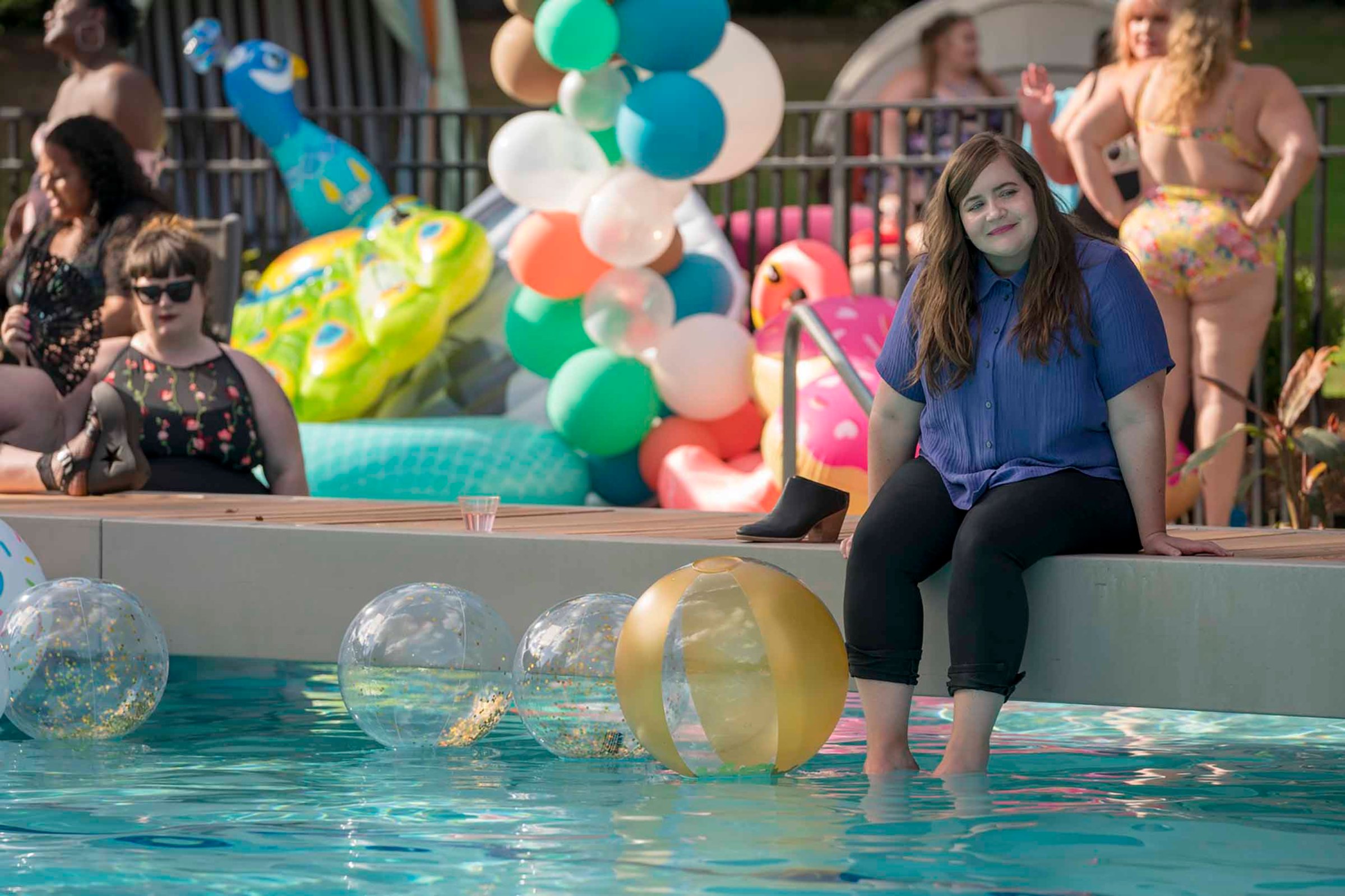
There’s a scene in the new Hulu Dramedy Shrill that I can’t get out of my head. Upon arriving at an event called the Fat Babe Pool Party, heroine Annie (Saturday Night Live‘s Aidy Byrant), an assistant at a Portland, Ore., alt-weekly, and her roommate Fran (Lolly Adefope) are awestruck. Amid pastel balloons, plush pillows and animal-shaped inflatables, self-identified fat women of all proportions wade and lounge in swimsuits without shame. As Fran hits on the hostess, Annie, whose jeans and blouse betray her discomfort with her own plus-size form, gets pulled into a dance party. The camera lingers on appreciative (but not creepy) shots of jiggly flesh.
It’s a startling set piece–not just because it ends with Annie stripping down to her one-piece, but also because it shows us something we rarely see on TV. Even as inclusion becomes a Hollywood watchword, it’s a rare mainstream narrative that allows female characters who don’t meet impossible beauty standards to enjoy their lives, let alone their bodies. This is Shrill‘s greatest triumph: it establishes a fat-positive gaze that humanizes rather than humiliates. But its greatest failure, one that works against that radicalism, is its insistence on connecting Annie’s every struggle to her weight.
Based on journalist and comedian Lindy West’s essay collection Shrill: Notes From a Loud Woman, the show opens with a series of indignities rooted in Annie’s size and resultant low self-esteem. A personal trainer pesters her in a coffee shop to schedule a session. Her mom (Julia Sweeney) admonishes her for complaining about the revolting frozen-dinner diet they’ve gone on together. Her boss Gabe (John Cameron Mitchell), an aging punk who pens diatribes against obesity, rejects Annie’s story ideas. In bed with steady hookup Ryan (Luka Jones), she agrees to sex without a condom, then slips out a back door so his friends don’t see her, takes the morning-after pill and gets pregnant anyway because she exceeds its weight limit. The pilot ends with a refreshingly unceremonious abortion. Annie vows to start valuing herself more.
Thus begins her quest to extract the same respect from others. She stands up for herself with Ryan and Gabe–and responds to one of Gabe’s rants by posting a rogue rebuttal to the paper’s website. (West published a similar viral piece in 2011, out of frustration with the chronic fatphobia of her Stranger colleague, the sex columnist Dan Savage.) In a plot adapted from West’s best-known essay, Annie confronts an Internet troll fixated on her size, and he immediately confesses that he hates himself.
Though Bryant makes a likable, authentic lead, these constant crusades make Annie a bit one-note. A supporting cast that’s long on charm seems stymied by characters short on interiority. These are likely side effects of adapting personal essays. An almost inevitably (and sometimes purposely) solipsistic form, this kind of narrative by definition reduces the author’s experiences and personality to vehicles for a larger revelation. Unfortunately, such limited character development pushes Shrill into the same frustrating territory as so many other TV series about fat women.
Whether they’re self-loathing sad sacks (see: “Fatty Patty” on Netflix’s noxious Insatiable, Chrissy Metz’s Kate Pearson on This Is Us) or the Strong Female Protagonists of supposedly subversive shows like Drop Dead Diva and 2018’s short-lived Dietland, women on TV who are bigger than a size 12 end up reckoning with their weight in practically every episode. Sure, it’s exciting to see the best of these characters overcome the self-loathing that’s been instilled in them. But like all underrepresented groups that are too often defined by their struggles, they’ll still feel like tokens until pop culture starts putting Shrill‘s fat-positive gaze to use in stories that have nothing to do with size.
More Must-Reads from TIME
- Why Biden Dropped Out
- Ukraine’s Plan to Survive Trump
- The Rise of a New Kind of Parenting Guru
- The Chaos and Commotion of the RNC in Photos
- Why We All Have a Stake in Twisters’ Success
- 8 Eating Habits That Actually Improve Your Sleep
- Welcome to the Noah Lyles Olympics
- Get Our Paris Olympics Newsletter in Your Inbox
Contact us at letters@time.com